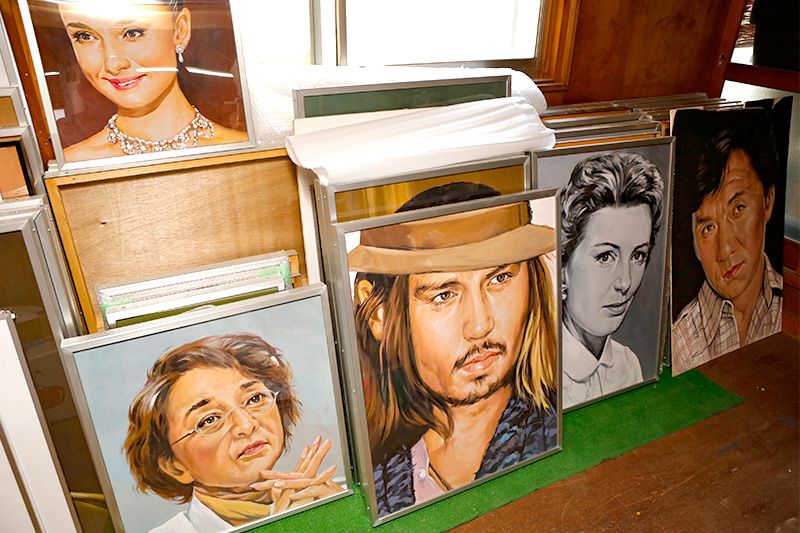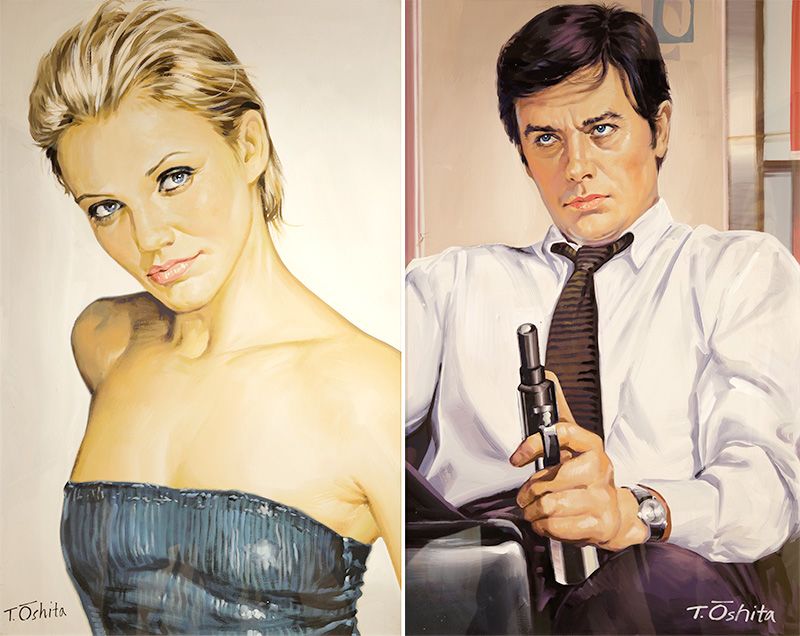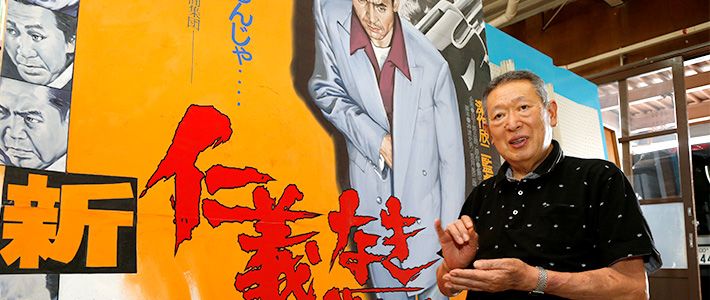
Revisiting Scenes of Timeless Nostalgia
Japan’s Movie Theater Sign Painter: Star Power in Acrylic
Cinema Culture- English
- 日本語
- 简体字
- 繁體字
- Français
- Español
- العربية
- Русский
In the golden age of movies, there were cinemas in almost every small Japanese town. Attendance figures peaked in 1958 at 1.1 billion, when the nation had more than 7,000 movie theaters. However, since the spread of television in the 1960s admissions have fallen steadily, along with the number of theaters. Japan’s first multiplex opened in Ebina, Kanagawa Prefecture, in 1993, leading a trend that pushed many smaller theaters into extinction. The rise of the multiplex meant that in 2016 there were 3,472 screens nationwide, but only 427 of these belonged to ordinary picture houses. And as local cinemas disappeared from regional Japanese cities, so too did their hand-painted signs, which were once an everyday sight.
Apprenticeship on a US Base
Before multiplexes, many theaters used to have their own dedicated sign painters. Ōshita Takeo was one of them. Born in Aomori Prefecture in 1942, he started out at the age of 16, producing signs for the theater at the US air base in Misawa. This meant that he was often working on Hollywood films.
“New American movies were shown at the Misawa base theater before they went on general release. The soldiers took their families to see them. At first, when the older painters went drinking in the izakaya, I used to sketch the stars on paper while studying their photos in Sukurīn [the movie magazine Screen]. Then I’d wait until the others came back and they’d fix them up for me.”
 One of Ōshita’s early signs at the Misawa base theater was for the John Wayne film North to Alaska, which opened in Japan in 1961. (Photograph provided by Ōshita Takeo)
One of Ōshita’s early signs at the Misawa base theater was for the John Wayne film North to Alaska, which opened in Japan in 1961. (Photograph provided by Ōshita Takeo)
From the beginning, reproducing faces accurately was important to Ōshita. He had always enjoyed painting, and in his first year at junior high school, he stunned his art teacher with a picture of a clenched fist. The teacher gave him a sheet of drawing paper every day and ensured he did not run out of materials. “Whenever I had a free moment, I was painting. But I made a fool of myself when I was asked to do a watercolor portrait of the head teacher for the school arts festival and it was a terrible likeness.”
He started work after he left junior high school. “Dad died in the war and the family didn’t have any money.” He says that he really wanted to be a baseball player. At 19, a connection got him a job in Mito as the sign painter for the Mito Tōei movie theater. “It was the only theater run directly by [major film corporation] Tōei in Ibaraki Prefecture. This was a time when being a sign painter under exclusive contract meant you knew you’d never starve.”
Working Until the Wee Hours
At Tōei, he was painting signs for yakuza movies with stars like Takakura Ken and Tsuruta Kōji almost every day. “When Takakura Ken was big, there’d be 1,700 spectators packed into a theater that was only meant to take 650, including standing room. Some people wouldn’t leave even after they’d seen the film once, which caused a major ruckus. I liked Takakura myself, and I’d get totally engrossed in the painting. His face was distinctive, so it was easy to do. But that soulful look of sorrow was what set him above all the standard stars.”
Between jobs for Tōei, other theaters asked Ōshita to paint just the faces of the actors for their own signs. He seemed to have earned a reputation for outstanding skills at reproducing visages and conveying their individual atmosphere. At 26, he went freelance. During the 1980s, he painted signs for all 11 of the theaters in Mito.
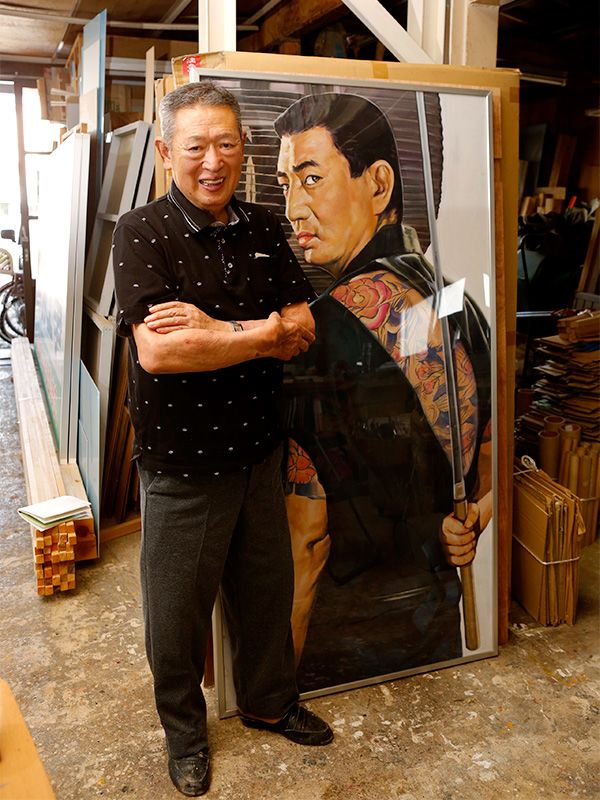 Ōshita stands in front of a favorite picture of Takakura Ken in the movie Shōwa zankyōden (Brutal Tales of Chivalry).
Ōshita stands in front of a favorite picture of Takakura Ken in the movie Shōwa zankyōden (Brutal Tales of Chivalry).
Each time, he put a checkered grid over the movie poster to transfer the pictures to an enlarged grid on the sign. He copied the design onto each square by pencil before adding color with acrylic paint. The standard signs were 2.4 meters high and 5.4 meters long, but some signs were different sizes. This meant he could not reproduce the poster exactly as it was. It also required experience to do a good job of adding layers of color with quick-drying paint. “Each sign took about a day and a half to complete. When I’d been doing it for a while, the right layout would jump into my head instantaneously.
“In my prime, I’d work with my wife every day until two or three in the morning.” After he got married at the age of 30 to Mitsue, who is three years younger, the couple tackled jobs as a team.
“My task was to stick the initial sketching paper on the sign. I’d do it with a baby strapped to my back,” Mitsue recalls. “Back then, the Japanese films changed every three days. They’d hang up the new signs the evening before opening. I was there on the truck too as we drove around all the theaters at night with a mountain of new signs piled up on the back. The job wasn’t just painting. You had to put up the signs and take them down as well.”
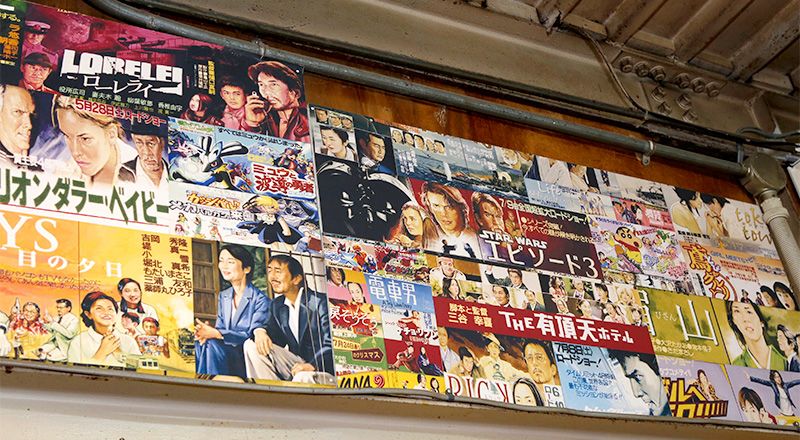 Ōshita’s studio walls are lined with photographs of his signs.
Ōshita’s studio walls are lined with photographs of his signs.
Ōshita spent all day every day painting signs, but still he says, “I was only satisfied with about one or two of them each year. All too often I’d paint a big X over my work and start over from scratch. But I never missed a deadline.” In later years, he used a projector to display the outlines for the design, which made things easier, but this technique did not work with extra-large posters.
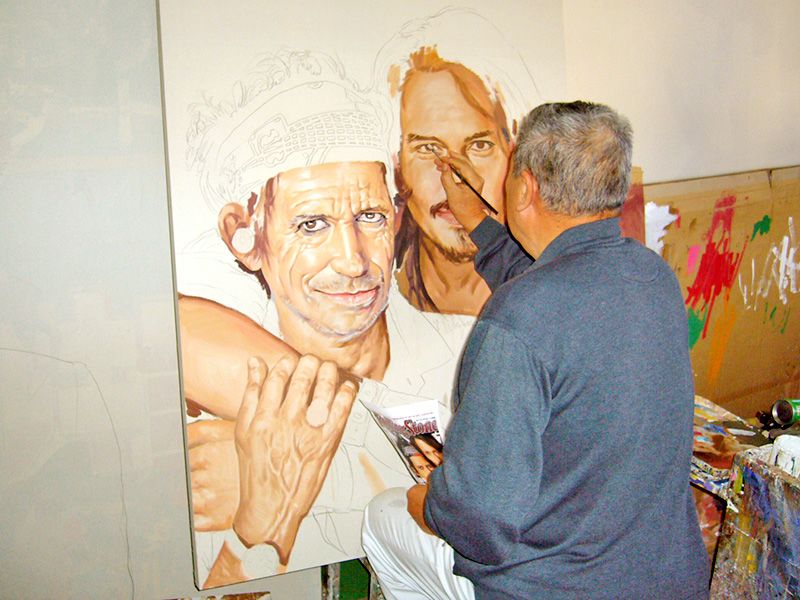 With quick-drying acrylic paint, the first 15 minutes of painting a face are crucial. (Photograph provided by Ōshita Takeo)
With quick-drying acrylic paint, the first 15 minutes of painting a face are crucial. (Photograph provided by Ōshita Takeo)
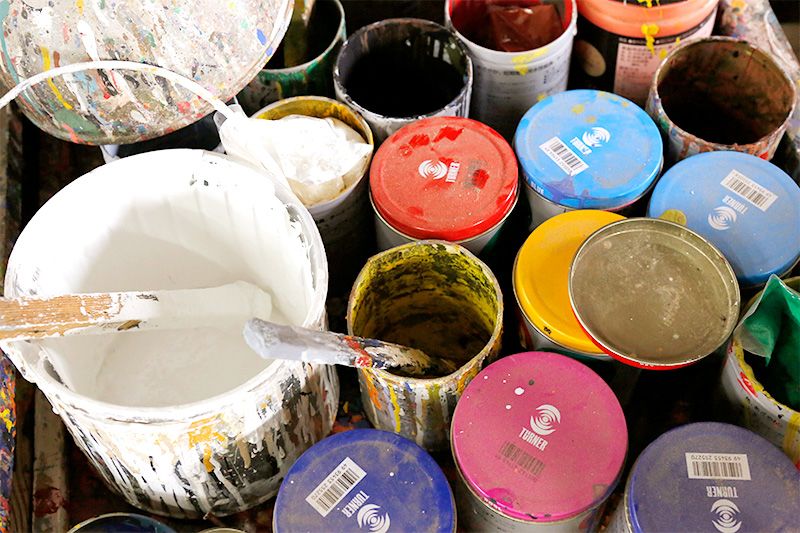 Ōshita shows his skill in rapidly producing the colors he wants with layers of paint.
Ōshita shows his skill in rapidly producing the colors he wants with layers of paint.
Audrey Hepburn and Kirk Douglas
Into the 2000s, Mito’s theaters closed one by one in competition with incoming multiplexes. After Mito Tōei shut down in 2006 and the mini theater Mito Theater Seiyū followed in 2008, there were no more regular sign-painting jobs.
Producing panels for events came to form the greater part of Ōshita’s work. However, some 20 years earlier he had begun painting portraits of stars in his free time. The more than 100 portraits created to date assemble a parade of Japanese and international actors past and present from Takakura Ken, Ishihara Yūjirō, and Atsumi Kiyoshi to Audrey Hepburn, Alain Delon, Bruce Willis, and Johnny Depp.
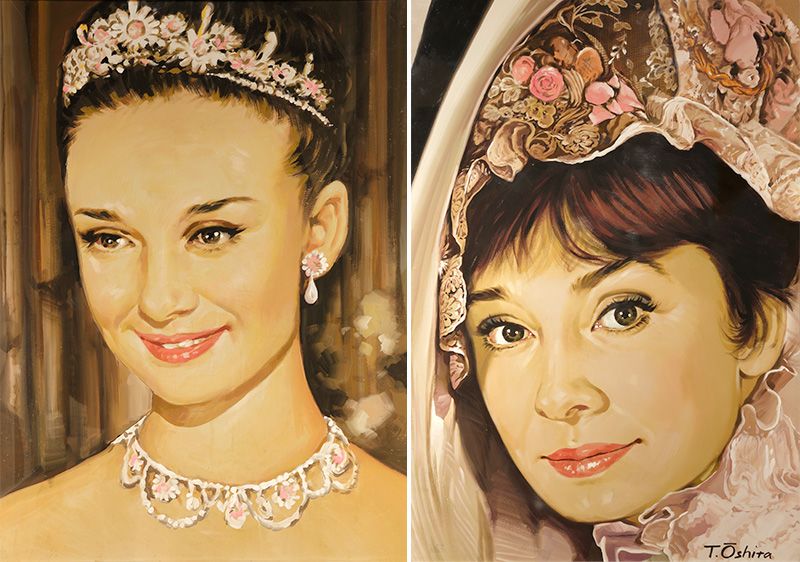 Audrey Hepburn in Roman Holiday (left) and My Fair Lady.
Audrey Hepburn in Roman Holiday (left) and My Fair Lady.
“I put most effort into getting the resemblance right and creating a soft, gentle look.” He says he is happiest when he gets the layering of paint right so the skin color is the same as the image he is working from. He is a fan of Audrey Hepburn, and has seen Roman Holiday nearly 10 times, including on video. Unfortunately, he has never had the chance to do a sign for one of her movies, but he has painted several portraits of her. He also likes Kirk Douglas. He enjoys Gunfight at the OK Corral in particular, in which Douglas played Western legend Doc Holliday, and he once painted a sign for the film.
Some of Ōshita’s movie star portraits are displayed on the walls outside Yokohama’s Cinema Novecento, a tiny movie theater with just 28 seats that mainly shows classic films.
Wiping Away Tears
An exhibition at a Mito museum from May to July introduced Ōshita’s portraits of stars, completed over two decades, to a new audience. Some 50 pictures went on display.
Curator Ōsone Makiko spoke about why she chose to run an exhibition of his works. “When I was a student, I often went to the movies here in Mito, and regularly saw Ōshita’s signs. But people in their twenties today have never seen hand-painted signs. I thought it was a real shame to let this culture fade away, and I wanted to show it to young people.”
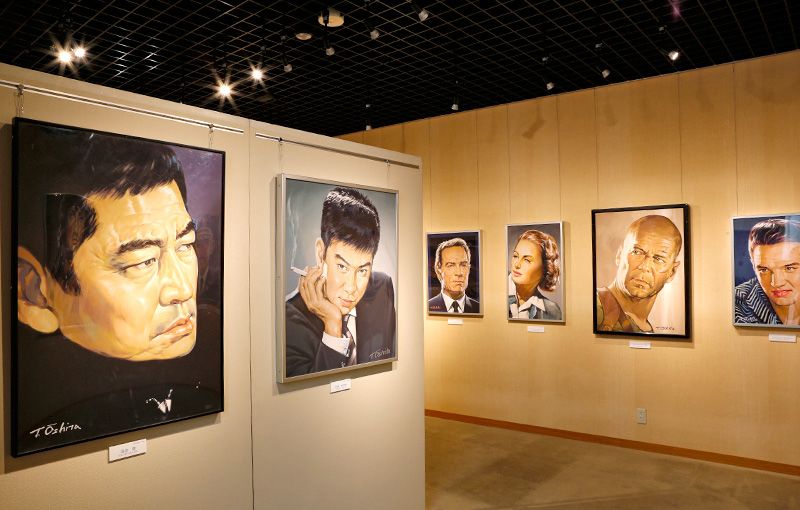 The exhibition of Ōshita’s signs was held at Jōyō Museum in Mito, Ibaraki Prefecture, from May 30 to July 16.
The exhibition of Ōshita’s signs was held at Jōyō Museum in Mito, Ibaraki Prefecture, from May 30 to July 16.
Nonetheless, the visitors who were most greatly moved were the older people viewing vivid portraits of the stars of their youth. Some women wiped away tears with their handkerchiefs as they stood in front of a picture of heartthrob Ishihara Yūjirō, who passed away 30 years ago this July.
When Ōshita was most active, crowds of commuters would walk in front of his signs outside Mito Tōei both morning and evening. “If you painted an oil painting, there wouldn’t be as many people seeing it each day. I was happy lots of people saw my work, and it motivated me to keep doing my best.”
Ōshita now rarely paints movie signs. The last major project he worked on was for the 2010 period drama Sakuradamon-gai no hen (Sakurada Gate Incident), which was filmed on an open set in Mito. He has had some heart problems in the last few years and is not in peak condition. Yet, he says his hand still moves when he’s sleeping at night. “It wants to keep painting. There were so many long days when I was rushing to complete a sign before the deadline.”
“The people at Mito Tōei told me they wanted me to always paint their signs, and I did for many years, but then it closed down. It’s sad, but I feel I fulfilled my responsibility.” Saying this, Ōshita gives a gentle smile.
(Originally written in Japanese by Itakura Kimie of Nippon.com. Photos by Ōkubo Keizō, unless otherwise stated. Banner photo: Ōshita talks in front of a sign for Shin jingi naki tatakai (New Battles Without Honor and Humanity) starring Sugawara Bunta.)
Movie Star Portraits by Ōshita Takeo
[output_slideshow image_id=b02102]
